Abstract
The polymerase chain reaction technique was used to develop a rapid diagnostic assay for detection of pathogenic Yersinia enterocolitica strains. The assay targeted a stretch of 163 bp of the yst gene and could be applied to both pure cultures and crude DNA extracted from feces. The defined primer pair amplified the targeted sequence from only pathogenic strains and fecal samples seeded with the serotype O:3 strain of Y. enterocolitica, whereas neither nonpathogenic strains nor normal stools yielded any amplified fragments. Of the other Yersinia species and non-Yersinia species tested, only two strains of Y. kristensenii yielded the same amplified product. A 20-mer oligonucleotide probe specifically hybridized within the amplified yst fragment of Y. enterocolitica but did not hybridize with the amplified yst fragment of Y. kristensenii by Southern and dot blot hybridizations. This confirms the reliability of this diagnostic assay in both clinical and epidemiological studies. The availability of the extracted DNA for the polymerase chain reaction was checked by simultaneous amplification of a part of the 16S rDNA and the yst gene. The entire diagnostic assay, including a simplified technique for DNA extraction, the amplification process, and gel electrophoresis, could be completed within 1 working day, which is better than the time required for the time-consuming traditional techniques used in clinical laboratories.
Full text
PDF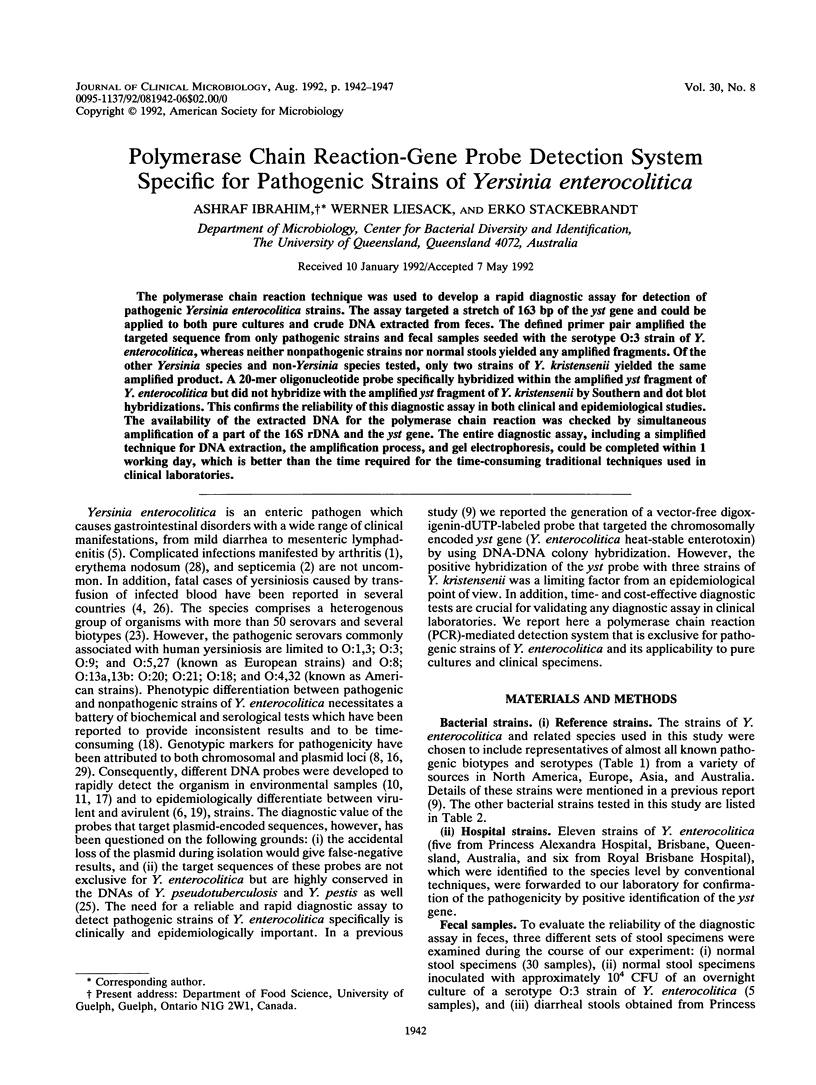
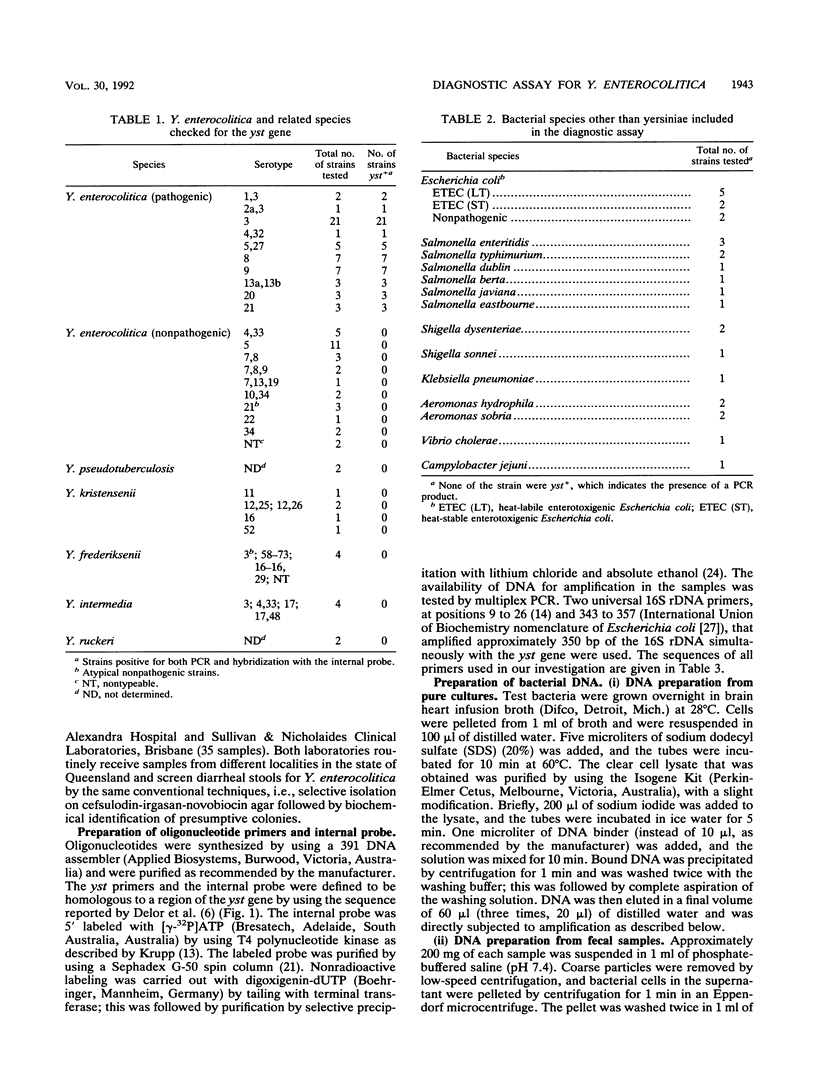
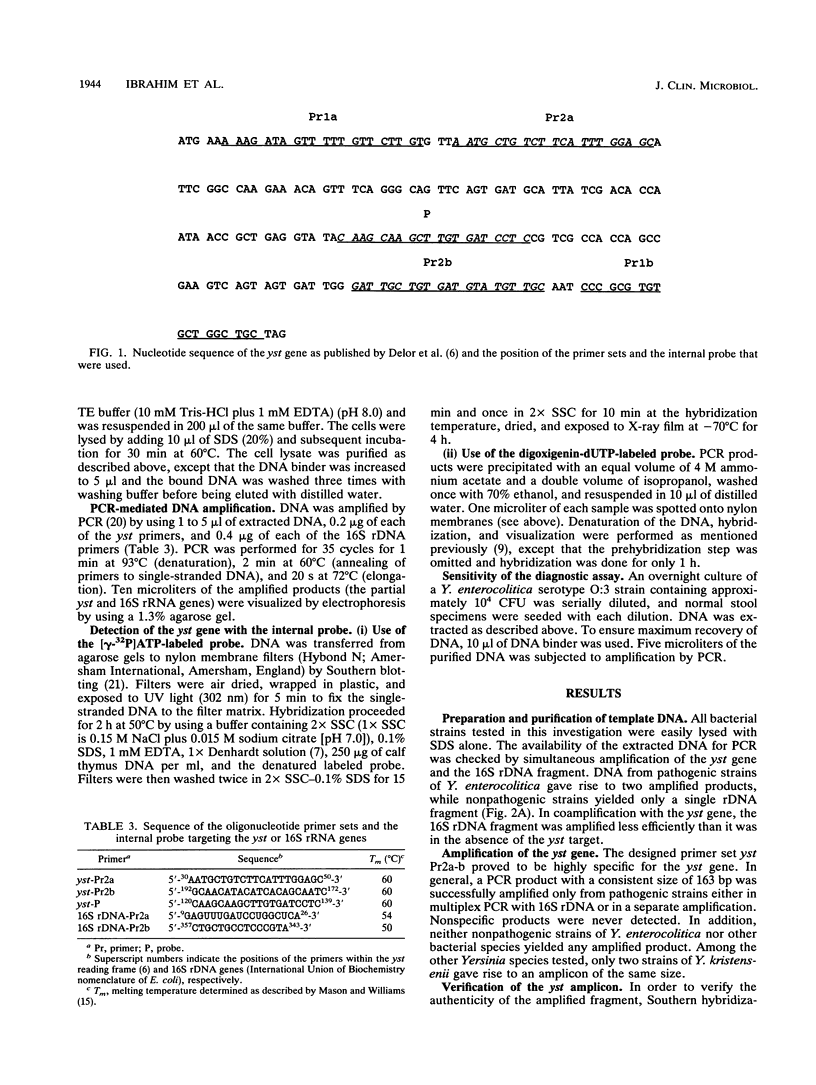
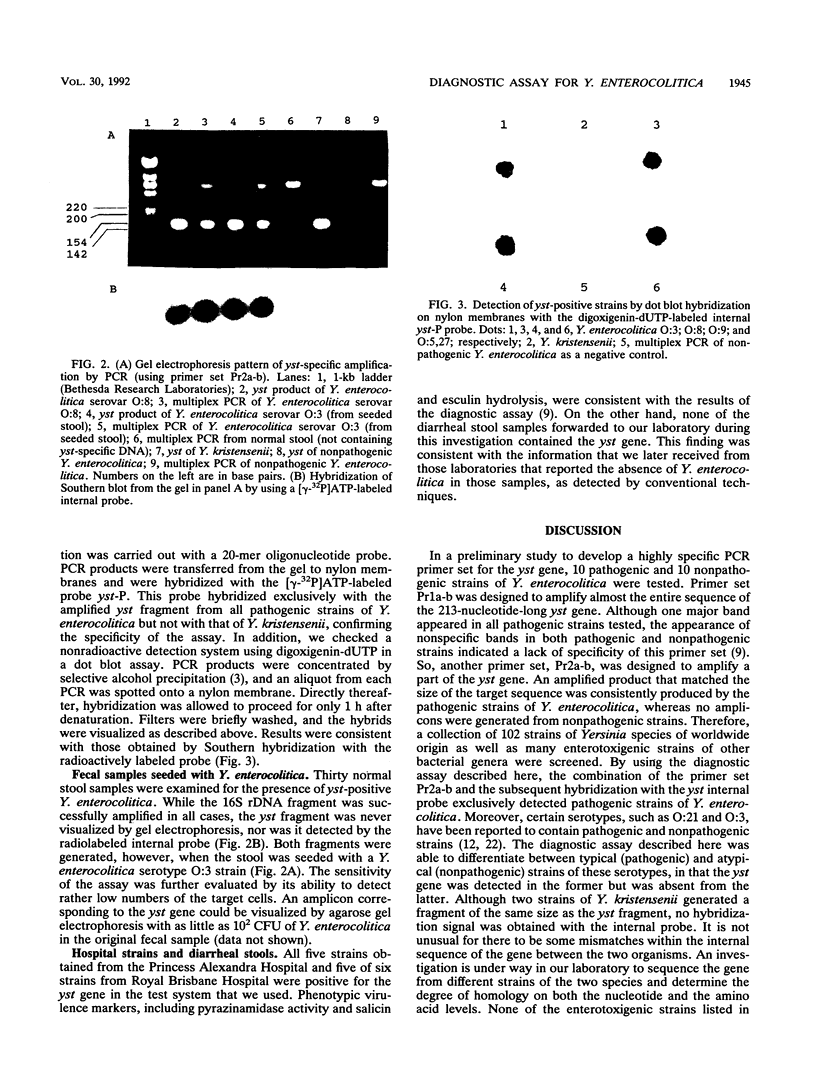
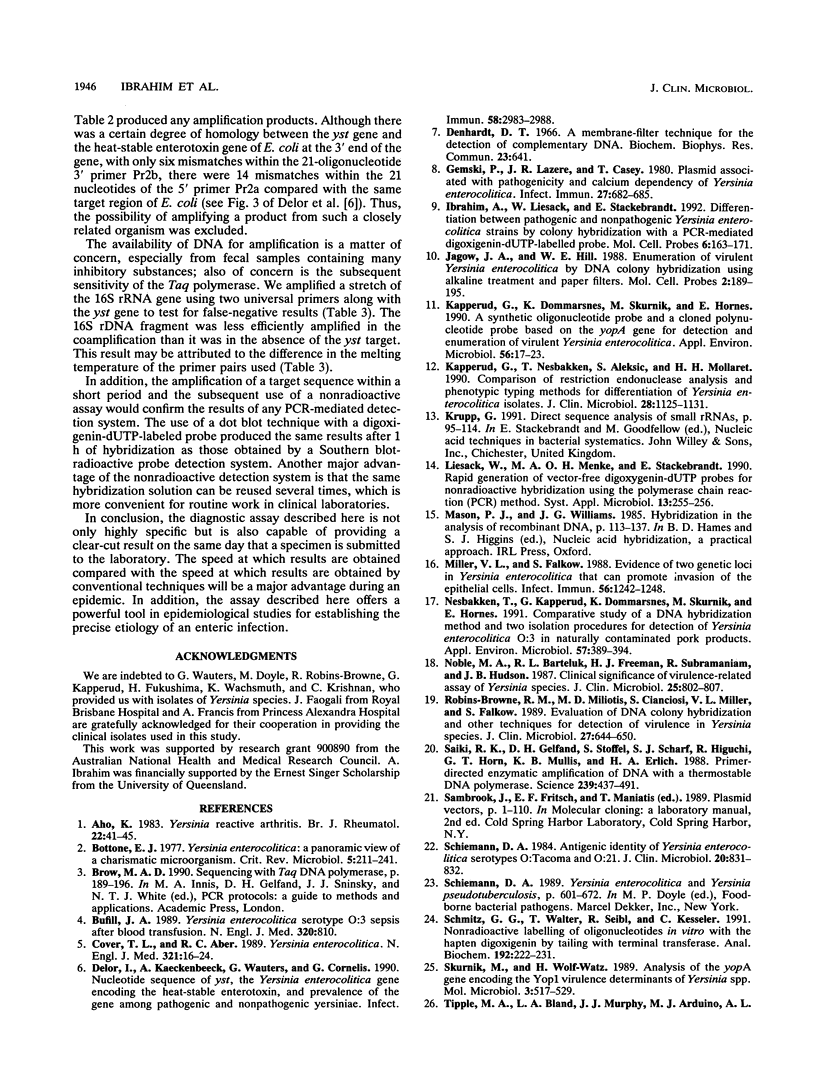

Images in this article
Selected References
These references are in PubMed. This may not be the complete list of references from this article.
- Aho K. Yersinia reactive arthritis. Br J Rheumatol. 1983 Nov;22(4 Suppl 2):41–45. doi: 10.1093/rheumatology/xxii.suppl_2.41. [DOI] [PubMed] [Google Scholar]
- Bottone E. J. Yersinia enterocolitica: a panoramic view of a charismatic microorganism. CRC Crit Rev Microbiol. 1977;5(2):211–241. doi: 10.3109/10408417709102312. [DOI] [PubMed] [Google Scholar]
- Bufill J. A., Ritch P. S. Yersinia enterocolitica serotype 0:3 sepsis after blood transfusion. N Engl J Med. 1989 Mar 23;320(12):810–810. doi: 10.1056/NEJM198903233201220. [DOI] [PubMed] [Google Scholar]
- Cover T. L., Aber R. C. Yersinia enterocolitica. N Engl J Med. 1989 Jul 6;321(1):16–24. doi: 10.1056/NEJM198907063210104. [DOI] [PubMed] [Google Scholar]
- Delor I., Kaeckenbeeck A., Wauters G., Cornelis G. R. Nucleotide sequence of yst, the Yersinia enterocolitica gene encoding the heat-stable enterotoxin, and prevalence of the gene among pathogenic and nonpathogenic yersiniae. Infect Immun. 1990 Sep;58(9):2983–2988. doi: 10.1128/iai.58.9.2983-2988.1990. [DOI] [PMC free article] [PubMed] [Google Scholar]
- Denhardt D. T. A membrane-filter technique for the detection of complementary DNA. Biochem Biophys Res Commun. 1966 Jun 13;23(5):641–646. doi: 10.1016/0006-291x(66)90447-5. [DOI] [PubMed] [Google Scholar]
- Gemski P., Lazere J. R., Casey T. Plasmid associated with pathogenicity and calcium dependency of Yersinia enterocolitica. Infect Immun. 1980 Feb;27(2):682–685. doi: 10.1128/iai.27.2.682-685.1980. [DOI] [PMC free article] [PubMed] [Google Scholar]
- Ibrahim A., Liesack W., Stackebrandt E. Differentiation between pathogenic and non-pathogenic Yersinia enterocolitica strains by colony hybridization with a PCR-mediated digoxigenin-dUTP-labelled probe. Mol Cell Probes. 1992 Apr;6(2):163–171. doi: 10.1016/0890-8508(92)90061-2. [DOI] [PubMed] [Google Scholar]
- Jagow J. A., Hill W. E. Enumeration of virulent Yersinia enterocolitica colonies by DNA colony hybridization using alkaline treatment and paper filters. Mol Cell Probes. 1988 Sep;2(3):189–195. doi: 10.1016/0890-8508(88)90003-5. [DOI] [PubMed] [Google Scholar]
- Kapperud G., Dommarsnes K., Skurnik M., Hornes E. A synthetic oligonucleotide probe and a cloned polynucleotide probe based on the yopA gene for detection and enumeration of virulent Yersinia enterocolitica. Appl Environ Microbiol. 1990 Jan;56(1):17–23. doi: 10.1128/aem.56.1.17-23.1990. [DOI] [PMC free article] [PubMed] [Google Scholar]
- Kapperud G., Nesbakken T., Aleksic S., Mollaret H. H. Comparison of restriction endonuclease analysis and phenotypic typing methods for differentiation of Yersinia enterocolitica isolates. J Clin Microbiol. 1990 Jun;28(6):1125–1131. doi: 10.1128/jcm.28.6.1125-1131.1990. [DOI] [PMC free article] [PubMed] [Google Scholar]
- Miller V. L., Falkow S. Evidence for two genetic loci in Yersinia enterocolitica that can promote invasion of epithelial cells. Infect Immun. 1988 May;56(5):1242–1248. doi: 10.1128/iai.56.5.1242-1248.1988. [DOI] [PMC free article] [PubMed] [Google Scholar]
- Nesbakken T., Kapperud G., Dommarsnes K., Skurnik M., Hornes E. Comparative study of a DNA hybridization method and two isolation procedures for detection of Yersinia enterocolitica O:3 in naturally contaminated pork products. Appl Environ Microbiol. 1991 Feb;57(2):389–394. doi: 10.1128/aem.57.2.389-394.1991. [DOI] [PMC free article] [PubMed] [Google Scholar]
- Noble M. A., Barteluk R. L., Freeman H. J., Subramaniam R., Hudson J. B. Clinical significance of virulence-related assay of Yersinia species. J Clin Microbiol. 1987 May;25(5):802–807. doi: 10.1128/jcm.25.5.802-807.1987. [DOI] [PMC free article] [PubMed] [Google Scholar]
- Robins-Browne R. M., Miliotis M. D., Cianciosi S., Miller V. L., Falkow S., Morris J. G., Jr Evaluation of DNA colony hybridization and other techniques for detection of virulence in Yersinia species. J Clin Microbiol. 1989 Apr;27(4):644–650. doi: 10.1128/jcm.27.4.644-650.1989. [DOI] [PMC free article] [PubMed] [Google Scholar]
- Saiki R. K., Gelfand D. H., Stoffel S., Scharf S. J., Higuchi R., Horn G. T., Mullis K. B., Erlich H. A. Primer-directed enzymatic amplification of DNA with a thermostable DNA polymerase. Science. 1988 Jan 29;239(4839):487–491. doi: 10.1126/science.2448875. [DOI] [PubMed] [Google Scholar]
- Schiemann D. A. Antigenic identity of Yersinia enterocolitica serotypes O:Tacoma and O21. J Clin Microbiol. 1984 Oct;20(4):831–832. doi: 10.1128/jcm.20.4.831-832.1984. [DOI] [PMC free article] [PubMed] [Google Scholar]
- Schmitz G. G., Walter T., Seibl R., Kessler C. Nonradioactive labeling of oligonucleotides in vitro with the hapten digoxigenin by tailing with terminal transferase. Anal Biochem. 1991 Jan;192(1):222–231. doi: 10.1016/0003-2697(91)90212-c. [DOI] [PubMed] [Google Scholar]
- Skurnik M., Wolf-Watz H. Analysis of the yopA gene encoding the Yop1 virulence determinants of Yersinia spp. Mol Microbiol. 1989 Apr;3(4):517–529. doi: 10.1111/j.1365-2958.1989.tb00198.x. [DOI] [PubMed] [Google Scholar]
- Tipple M. A., Bland L. A., Murphy J. J., Arduino M. J., Panlilio A. L., Farmer J. J., 3rd, Tourault M. A., Macpherson C. R., Menitove J. E., Grindon A. J. Sepsis associated with transfusion of red cells contaminated with Yersinia enterocolitica. Transfusion. 1990 Mar-Apr;30(3):207–213. doi: 10.1046/j.1537-2995.1990.30390194338.x. [DOI] [PubMed] [Google Scholar]
- Woese C. R., Gutell R., Gupta R., Noller H. F. Detailed analysis of the higher-order structure of 16S-like ribosomal ribonucleic acids. Microbiol Rev. 1983 Dec;47(4):621–669. doi: 10.1128/mr.47.4.621-669.1983. [DOI] [PMC free article] [PubMed] [Google Scholar]
- Zink D. L., Feeley J. C., Wells J. G., Vanderzant C., Vickery J. C., Roof W. D., O'Donovan G. A. Plasmid-mediated tissue invasiveness in Yersinia enterocolitica. Nature. 1980 Jan 10;283(5743):224–226. doi: 10.1038/283224a0. [DOI] [PubMed] [Google Scholar]




